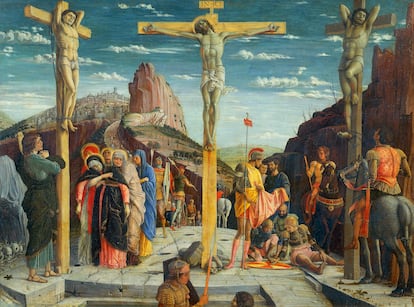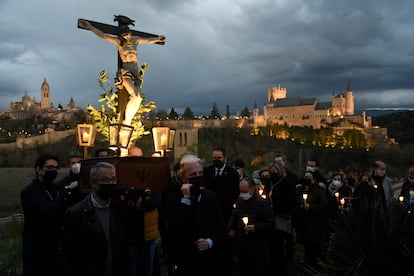The forgotten men crucified with Jesus at Golgotha
Holy Week could be meaningful for non-Christians if it commemorated all the victims of power, not just one man 2,000 years ago

There is something intellectually and ethically disturbing about Christian Holy Week commemorations of the passion and death on the cross of Jesus of Nazareth. Beyond the inertia of liturgy and tradition, remembering the victim of such barbaric torture is certainly valid and understandable. What is worrying is that the two men crucified with Jesus are not remembered. The canonical Gospels themselves state that a collective crucifixion took place on Golgotha, the hill outside Jerusalem. But the eagerness to celebrate Holy Week seems strikingly selective, since it does not extend to these other unfortunates.
This selective memory conveniently ignores the mistreatment of two men who undoubtedly suffered on the way to the cross, as well as the torment of crucifixion itself, which was surely as painful as Jesus’ death. They have become insignificant shadows — vulgar thieves, they are called. They have been reduced to secondary and negligible details of the Son of God’s tragic agony. Christianity’s second-greatest commandment is “love your neighbor.” Why is this religious tradition so forgetful of the suffering of other executed human beings?
Damnatio memoriae is a term to describe the Roman practice of erasing the memory of a person who was a tyrant, traitor, or other enemy of the state. Unlike Jesus, the memory of the two men crucified at his side clearly was erased. Yet no one seems to care except for some inquisitive historians who never stopped wondering about them. With so little information to go on, how could they possibly find out anything about these men? The search seemed futile, but as always, the truth lurked in the details.
Mark, presumably the first Gospel writer, described these men as lestai (Matthew also used this word in his Gospel). Contrary to popular belief, the Greek word does not mean “thieves.” More correctly, it means “bandits” or “brigands.” It’s the same word frequently used by Jewish historian Flavius Josephus and other Roman authors to refer derogatorily to insurgents who opposed the Roman Empire. According to several sources, in a Palestine ruled by Rome, crucifixion was a sentence applied almost exclusively to political rebels and their collaborators. This implies that the two men crucified with Jesus were not simple thieves, but patriots, insurgents and freedom fighters.
Now the scene at Golgotha makes more sense, for why would thieves be crucified along with the greatest threat to the Roman Empire in Palestine? The sign on Jesus’ cross read, “King of the Jews.” This was not merely a malicious accusation, but a royal claim made by Jesus himself and recorded in scripture. But to the Roman Empire, this was an unequivocal crime of lèse-majesté, as it involved a call to subversion and independence. The relationship between the three crucified men is now clearer, and we can better understand why Pontius Pilate had them executed together in the same way, time and place — all three were enemies of Rome.

Many scholars (since the 16th century) from a wide range of ideological backgrounds have concluded that the apocalyptic and visionary Jesus must have been involved in some kind of anti-Rome resistance. These scholars point to New Testament evidence of Jesus’ contemptuous words and attitudes towards non-Jews (whom he once called “dogs”); his choice of 12 disciples to symbolize the 12 tribes of Israel; his longing to reconstitute the Jewish people, his promise to those disciples that they would one day rule over Israel; the traces of deep hostility between Jesus and the pre-Roman Herod Antipas; his claim to be the messianic king; the (plausible) accusation that he opposed paying tribute to the Roman Empire; his order to the disciples to arm themselves; and certain traces of violent behavior. These scholars believe all these elements converge into a physiognomy dramatically different from the meek demeanor that theologians and their followers have constructed.
Worshipers believe the object of their veneration is unique and incomparable, and they elevate their god or idol to an exalted and enigmatic position. Historians do just the opposite — they reinsert the character in context and relate him to others by virtue of the fundamental truth that no human being is an island. Historians then analyze and render the venerated one into something humanly comprehensible. This unrelenting rigor has been applied to Jesus/Yeshua, son of Joseph, a Jew whose life and death only gain full meaning in a Palestine ruled by Rome in the first century of the common era.
A strictly historical approach is illuminating because the belief in Jesus’ resurrection celebrated on Easter Sunday can be best understood through disciplined research and reasoning. The process of Jesus’ magnification and conversion into God was of course complex, but its genesis and development can be explained not only in terms of the intense psychological needs of his initially disappointed disciples, but also in the light of the cultures of the Mediterranean basin. The virgin birth, pre-existence, thaumaturgy, vicarious death, immortality, ascension to heaven, resurrection as deification — these are all notions already found in the polymorphous religiosity of the Greco-Roman period, from where they were consciously or unconsciously taken. Far from being the mystery proclaimed from certain pulpits and positions, the divinization of Jesus is an intelligible phenomenon.
Holy Week could be meaningful for non-Christians if it were more than a commemoration of the brutal death of a single man 2,000 years ago. Holy Week could become more significant if it commemorated the violated dignity of every victim of vicious power, including those crucified with Jesus on the outskirts of Jerusalem. Or perhaps a commemoration of people today whose lives continue to be crushed by criminal states. After all, the infamies and outrages of despots who dream of old or new empires are always with us. These barbarities are clearly visible today in the suffering of Eastern Europe, a suffering just as persistent as the annual Holy Week vigils and processions.
Sign up for our weekly newsletter to get more English-language news coverage from EL PAÍS USA Edition
Tu suscripción se está usando en otro dispositivo
¿Quieres añadir otro usuario a tu suscripción?
Si continúas leyendo en este dispositivo, no se podrá leer en el otro.
FlechaTu suscripción se está usando en otro dispositivo y solo puedes acceder a EL PAÍS desde un dispositivo a la vez.
Si quieres compartir tu cuenta, cambia tu suscripción a la modalidad Premium, así podrás añadir otro usuario. Cada uno accederá con su propia cuenta de email, lo que os permitirá personalizar vuestra experiencia en EL PAÍS.
¿Tienes una suscripción de empresa? Accede aquí para contratar más cuentas.
En el caso de no saber quién está usando tu cuenta, te recomendamos cambiar tu contraseña aquí.
Si decides continuar compartiendo tu cuenta, este mensaje se mostrará en tu dispositivo y en el de la otra persona que está usando tu cuenta de forma indefinida, afectando a tu experiencia de lectura. Puedes consultar aquí los términos y condiciones de la suscripción digital.
More information
Últimas noticias
Most viewed
- Sinaloa Cartel war is taking its toll on Los Chapitos
- Oona Chaplin: ‘I told James Cameron that I was living in a treehouse and starting a permaculture project with a friend’
- Reinhard Genzel, Nobel laureate in physics: ‘One-minute videos will never give you the truth’
- Why the price of coffee has skyrocketed: from Brazilian plantations to specialty coffee houses
- Silver prices are going crazy: This is what’s fueling the rally









































